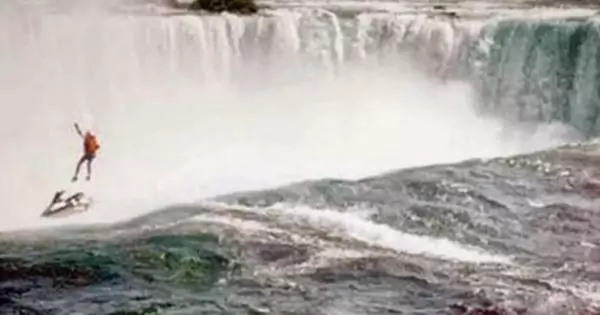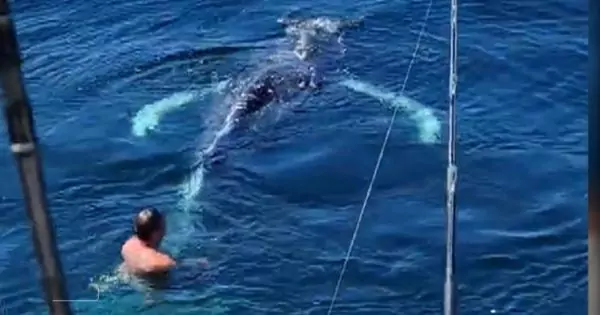
Niagara Falls has long been a symbol of nature’s awe-inspiring power. Straddling the border between the United States and Canada, this iconic waterfall attracts millions of visitors from around the world every year. For some, it has also been a magnet for daring stunts and life-risking feats. One such tragic tale is that of Robert Overacker, an American stuntman whose attempt to conquer the Falls ended in disaster.
In 1995, tourists unknowingly captured Overacker’s fatal attempt to ride a jet ski over Niagara Falls and land safely using a parachute. Almost three decades later, this haunting event continues to capture the imagination of thrill-seekers and historians alike. This is the story of Overacker’s ill-fated journey—a chilling moment in the history of daredevil stunts at Niagara Falls.
Raising Awareness Through a Dangerous Stunt
Robert Overacker wasn’t just a thrill-seeker. Originally from Camarillo, California, Overacker was a 39-year-old man on a mission. His goal was to bring attention to the growing issue of homelessness in the United States. To do so, he planned a dramatic and highly dangerous stunt at Niagara Falls—a place famous for its beauty, power, and deadly allure.

Overacker’s plan was as daring as it was risky. He aimed to ride a jet ski off the edge of Niagara Falls, free-fall over the Horseshoe Falls, and deploy a rocket-propelled parachute strapped to his back, allowing him to land safely in the river below. It was a stunt meant to draw the eyes of the world to a cause he deeply cared about. However, like many high-risk endeavors, things didn’t go as planned.
A Daring Stunt Turns into Tragedy
On October 1, 1995, Robert Overacker set his plan into motion. Starting near the Canadian Niagara Power Plant, he entered the rushing waters of the Niagara River on a lone jet ski. Thousands of tourists, unaware of what was about to unfold, watched as Overacker headed toward the edge of the world-famous Horseshoe Falls. His brother and a close friend were in the crowd, there to support him.
As the jet ski sped closer to the brink of the 51-meter (167 feet) drop, the crowd’s excitement grew. Daredevils had attempted stunts at Niagara Falls before, but each new effort always managed to captivate the public. Moments before reaching the precipice, Overacker made his leap of faith, expecting to deploy his parachute and glide to safety.
But in a terrifying twist, the parachute didn’t open. With no way to slow his fall, Overacker plunged into the violent waters below.
A Parachute Failure Seals His Fate
The spectators watched in horror. Some had been filming the stunt, expecting a spectacular success, but instead witnessed a disaster. The footage showed Overacker’s leap over the falls, but it cut off soon after. At first glance, some might have thought Overacker had survived. People even speculated that he appeared to be swimming in the rapids.
But the truth was far grimmer. The rapids were tossing Overacker’s body around, making it seem as if he were moving. In reality, the force of the water had overwhelmed him. The crew of the Maid of the Mist, a popular boat tour operating at the base of the falls, recovered his body from the water. He was taken to Niagara General Hospital, where doctors pronounced him dead. Overacker left behind a grieving wife.

His death made him the 15th person since 1901 to intentionally go over Niagara Falls using some sort of device.
Stuntmen and Niagara Falls
Robert Overacker’s fatal attempt wasn’t the first tragedy at Niagara Falls, and it wouldn’t be the last. Since 1901, 15 individuals have gone over the falls intentionally, using various devices. While some survived, others, like Overacker, lost their lives. Despite the obvious dangers, the allure of conquering Niagara Falls continues to attract daredevils.
Since Overacker’s death in 1995, six more incidents of people attempting to go over the falls have occurred. Two of these resulted in fatalities. For some, the goal is fame and fortune. For others, it’s the thrill of surviving one of nature’s most powerful forces. As Overacker’s story demonstrates, even the most carefully planned stunts can quickly turn deadly when faced with the might of the falls.
Other Notable Daredevils ‘Kirk Jones’ Story
One of the most famous daredevils to follow Overacker was Kirk Jones. In 2003, Jones made headlines as the first person to survive going over Niagara Falls without any protective gear. Unlike Overacker, Jones had no cause or rehearsed stunt in mind. His plunge into the falls came after a night of drinking with friends. Some believed Jones intended to take his own life, though he later claimed the jump was accidental.
Despite surviving the fall, Jones faced legal consequences. He received a fine of CA $2,300 (£1,280) and was banned from entering Canada for life. Although he survived the first time, Jones wasn’t done with Niagara Falls.
In April 2017, Jones attempted another stunt, this time using an inflatable ball. The ball spun wildly as it approached the American Falls. The Maid of the Mist crew later recovered the ball, but Jones’ body was found two months later near Lake Ontario. His tragic story is a reminder that even experienced thrill-seekers are not immune to the deadly force of Niagara Falls.
Why Niagara Falls? The Lure of the Falls for Stuntmen
Why do daredevils keep risking their lives at Niagara Falls? The answer lies in the falls’ combination of beauty and danger. The size and power of the waterfall make it an irresistible challenge for those seeking to push the limits of human endurance.
From the first recorded stunt in 1829, when Sam Patch leaped from a high platform into the gorge below the falls, Niagara Falls has drawn thrill-seekers. Some used barrels, jet skis, or even tightropes to try and conquer the falls. Each generation of daredevils sees the falls as the ultimate test of bravery, often ignoring the fatal consequences that have claimed so many lives.
Are These Stunts Worth the Risk?
While many admire the courage of daredevils like Overacker and Jones, others view these stunts as reckless. The Niagara Falls Parks Commission has long opposed such acts, citing the danger not only to the performers but also to the rescue teams. Every time a new stunt is attempted, it puts more lives at risk.

There’s also the concern of glorifying dangerous behavior. When these acts gain public attention, they can inspire copycats. Despite Overacker’s tragic death, six others have followed his path since 1995. The question remains: Are these stunts acts of bravery or are they needless risks?
A Legacy of Risk and Tragedy
Robert Overacker’s ill-fated stunt at Niagara Falls is a sobering reminder of the dangers that come with challenging nature. His story, along with others who have followed in his footsteps, shows the unpredictable power of Niagara Falls and the fine line between success and disaster.
For most people, Niagara Falls remains a breathtaking natural wonder—a place to admire from a distance. But for a select few, it represents a challenge they cannot resist. Overacker’s story continues to echo through the history of Niagara Falls, reminding us that even the most carefully planned stunts can lead to tragedy.

























































































































